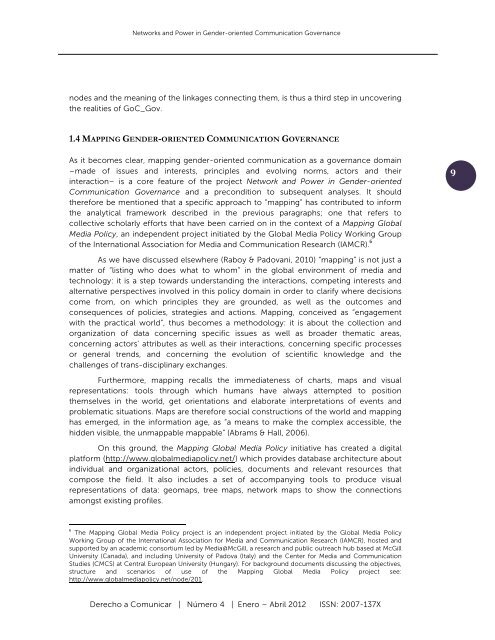21aiiMmFK
21aiiMmFK
21aiiMmFK
You also want an ePaper? Increase the reach of your titles
YUMPU automatically turns print PDFs into web optimized ePapers that Google loves.
Networks and Power in Gender-oriented Communication Governance<br />
nodes and the meaning of the linkages connecting them, is thus a third step in uncovering<br />
the realities of GoC_Gov.<br />
1.4 MAPPING GENDER-ORIENTED COMMUNICATION GOVERNANCE<br />
As it becomes clear, mapping gender-oriented communication as a governance domain<br />
–made of issues and interests, principles and evolving norms, actors and their<br />
interaction– is a core feature of the project Network and Power in Gender-oriented<br />
Communication Governance and a precondition to subsequent analyses. It should<br />
therefore be mentioned that a specific approach to “mapping” has contributed to inform<br />
the analytical framework described in the previous paragraphs; one that refers to<br />
collective scholarly efforts that have been carried on in the context of a Mapping Global<br />
Media Policy, an independent project initiated by the Global Media Policy Working Group<br />
of the International Association for Media and Communication Research (IAMCR). 6<br />
9 <br />
As we have discussed elsewhere (Raboy & Padovani, 2010) “mapping” is not just a<br />
matter of “listing who does what to whom” in the global environment of media and<br />
technology: it is a step towards understanding the interactions, competing interests and<br />
alternative perspectives involved in this policy domain in order to clarify where decisions<br />
come from, on which principles they are grounded, as well as the outcomes and<br />
consequences of policies, strategies and actions. Mapping, conceived as “engagement<br />
with the practical world”, thus becomes a methodology: it is about the collection and<br />
organization of data concerning specific issues as well as broader thematic areas,<br />
concerning actors’ attributes as well as their interactions, concerning specific processes<br />
or general trends, and concerning the evolution of scientific knowledge and the<br />
challenges of trans-disciplinary exchanges.<br />
Furthermore, mapping recalls the immediateness of charts, maps and visual<br />
representations: tools through which humans have always attempted to position<br />
themselves in the world, get orientations and elaborate interpretations of events and<br />
problematic situations. Maps are therefore social constructions of the world and mapping<br />
has emerged, in the information age, as “a means to make the complex accessible, the<br />
hidden visible, the unmappable mappable” (Abrams & Hall, 2006).<br />
On this ground, the Mapping Global Media Policy initiative has created a digital<br />
platform (http://www.globalmediapolicy.net/) which provides database architecture about<br />
individual and organizational actors, policies, documents and relevant resources that<br />
compose the field. It also includes a set of accompanying tools to produce visual<br />
representations of data: geomaps, tree maps, network maps to show the connections<br />
amongst existing profiles.<br />
6<br />
The Mapping Global Media Policy project is an independent project initiated by the Global Media Policy<br />
Working Group of the International Association for Media and Communication Research (IAMCR), hosted and<br />
supported by an academic consortium led by Media@McGill, a research and public outreach hub based at McGill<br />
University (Canada), and including University of Padova (Italy) and the Center for Media and Communication<br />
Studies (CMCS) at Central European University (Hungary). For background documents discussing the objectives,<br />
structure and scenarios of use of the Mapping Global Media Policy project see:<br />
http://www.globalmediapolicy.net/node/201.<br />
Derecho a Comunicar | Número 4 | Enero – Abril 2012 ISSN: 2007-137X



